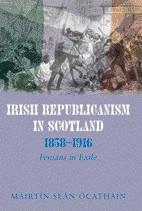Irish Republicanism in Scotland, 1858–1916: Fenians in exile
Published in 18th–19th - Century History, 20th-century / Contemporary History, General, Irish Republican Brotherhood / Fenians, Issue 6 (Nov/Dec 2008), Reviews, Volume 16 Irish Republicanism in Scotland, 1858–1916: Fenians in exile
Irish Republicanism in Scotland, 1858–1916: Fenians in exile
Máirtín S. Ó Catháin
(Irish Academic Press, €24.95/£19.95 pb)
ISBN 97807165 28586
During the heady days of 1867 and 1868, the Dublin rising, the Manchester Martyrs, the Clerkenwell prison bomb, the abortive raid on Chester Castle and many smaller episodes ensured that Fenianism generated endless column inches in British newspapers. By an index of newsworthiness alone, Fenianism was important in Britain—perhaps more important there than it was in Ireland. Despite the debates about the importance of the Irish arm of Fenianism, there can be no doubting how firmly Fenianism was fastened onto the consciousness of the British people. Indeed, one of Máirtín Ó Catháin’s central conclusions is that Fenianism in Scotland was more radical than its Irish equivalent. The Scottish element was shaped by a durable consciousness of exile and emigration. In Scotland, unlike in Ireland, Fenians were drawn mostly from the lower classes; they laboured in the worst sorts of jobs in the dirtiest and most dangerous workplaces. In this respect, they were a microcosm of the Irish in Britain: low on the social scale and to some degree physically segregated.
One of the Fenians who sprang to prominence in the frenetic days of 1867 and 1868 was the Glasgow Irishman Michael Barrett, about whom Ó Catháin says much. Barrett, like John Torley and other Scottish Fenians, has been relatively overlooked compared to their fellow travellers elsewhere. Yet Barrett was well known to Victorians as one of the Fenians hanged for the Clerkenwell bombing, following a protracted investigation into the veracity of numerous alibis that stated he was elsewhere on the day the bungled attack—which demolished a row of houses and killed several innocent residents rather than releasing imprisoned Fenians—took place.
Barrett’s story has added piquancy since he was the last man to be hanged in public in England. Consequently the occupants of the houses around Newgate prison cashed in (more than usual) by offering onlookers the opportunity to watch him swing in full public view. The Glasgow Herald reckoned that some of these ghoulish persons were charged £10 for a room with a window overlooking the grisly scene. Barrett’s case captures much of the essence of Ó Catháin’s richly researched and original work, which connects Ireland, Scotland and England. For the Irish in Scotland, Barrett was their equivalent of the ‘Manchester Martyrs’, who also went to the gallows.
‘Fenianism’ is deployed by Ó Catháin as a catch-all term to encompass the gamut of physical-force nationalisms in Scotland and elsewhere. This is a slightly confusing aspect because by conflating in this way the author also implies a greater degree of continuity than may have existed. On the plus side, the attempt to embody so many traditions in this way ensures that the central narrative has legs beyond 1868, when the IRB drooped following Barrett’s execution. Furthermore, Ó Catháin recognises phases of amorphousness and atrophy within the traditions he is discussing. He also considers specific institutional frameworks: the Irish Republican Brotherhood, the National Brotherhood of St Patrick, the Irish National Brotherhood and others. To him, the Fenians were primary agents in the struggles of the Scots-Irish to resist assimilation, key representatives of an oppressed people who collectively remembered the maltreatment of their people in Ireland.
In most respects, Scotland represents a unique or different laboratory from other parts of the United Kingdom: its Irish community continued to be replenished with more significant ‘top-up’ migrations than the Irish in England. The Irish-born in Scotland even experienced an increase in numbers in the early twentieth century, whereas the Irish in England declined persistently after 1871. Scotland’s tangle of Calvinism, imperialism, industrialism, Liberalism and Labourism provided a uniquely intense context for the shaping of Irish political minds. The composition of the Irish communities of Scotland—heavy on Ulster folk and more Protestant than anywhere else in the British Isles—gave shape to a particular relationship between these parts of the two islands. Finally, Scotland’s proximity to Ireland’s most bellicose province also had its effects on the hardiness of physical-force traditions among its Irish communities.
Ó Catháin argues that Fenianism is a form of indigenous populism and that the Scottish example was a movement in exile. The author recognises the blurring between organisation and ideology. He argues that the populist dimension accounts for Fenianism’s survival and for its marginalisation. In this respect, Fenians were like the people they served: marginal but enduring. Like the movement, Ó Catháin’s book will endure because it cultivates new ground and brings together all of the available primary sources. It deserves to be widely read by those interested in Ireland and her diaspora.
Donald M. MacRaild is a professor in the School of History and International Affairs at the University of Ulster.
















